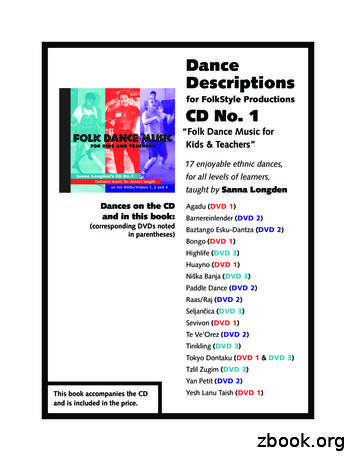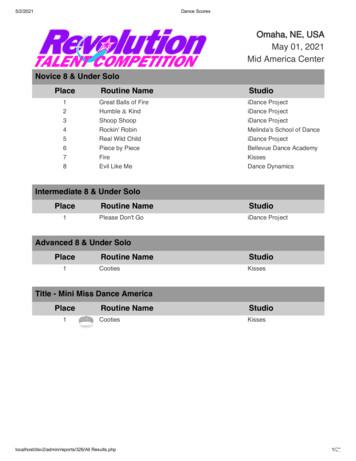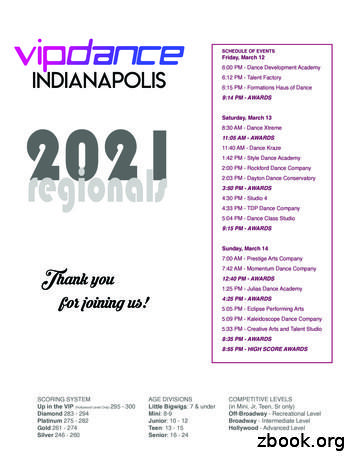Dance Media Arts Music Theatre Visual Arts
PARENTS’ GUIDE TO ARTS LEARNINGIN CALIFORNIA SCHOOLSGRADES 3–4–5Dance Media Arts Music Theatre Visual ArtsSnapshot of Arts Learning inThird GradeFourth grade students have become activeparticipants in their own learning. Building onwhat they learned and experiences in the artssince Pre-Kindergarten, they recognize the artistwithin themselves, and they see how they canapply what they have learned in each of the arts tolearning in other areas of the curriculum. Projectbased learning allows them to, for example, sharewhat they learned through monologues about animportant person from history and draw and paintpictures of landscapesor do murals thatrepresent the variousbiospheres in theworld. In mediaarts, students beginto identify andapply basic criteriafor evaluating andimproving mediaartworks. In music,they are ready topresent the finalversion of music theypersonally created and to explain the expressiveintent. In dance, they can present a study thatexpresses and communicates a significant main ideawhich is developed and performed.Students arecommunicatingthrough thearts as theyare expandingtheir creativeexpressionabilities.CAPTA.ORG CREATECA.NETGRADES 3-4-5Third graders get excited about describing theirthoughts orally and in writing, which leads them tomore creating, performing, presenting, producing,responding, and connecting in the arts. They usetheir skills in the arts to portray what they imagine.They create and perform original dance sequencesmore expressively and also perform dances fromvarious countries with a partner or a group. Thisadds to their collection of dance movements. Theydevelop multiple ideas for media artworks usinga variety of tools, methods, and materials andcomplete purposeful media arts productions. Theirmusical knowledge increases as they focus onrhythmic patterns, musical forms, melody, harmonyand timbre when reading, writing and performingmusic. Increased listening skills are applied as theyidentify those qualities in music selections. Singingfrom memory helps them improve their accuracy.In third grade, students explore how stories areadapted from literature to produce drama or theatreworks. Their visual arts experiences lead them tocreating the illusion of depth in a painting and theygain skills in a growing number of media such aswatercolor and printmaking. Students also becomefamiliar with local artists and their works as well asartists from throughout California and from variousparts of the world.Snapshot of Arts Learning inFourth Grade13
Dance Media Arts Music Theatre Visual ArtsThe key examples of arts learning that follow are based on the California Arts Standards. The purposes ofthe Arts Standards are to promote students’ lifelong appreciation and understanding of the arts in waysthat are enjoyable, fulfilling, and transferable to personal, academic, and professional pursuits. Learningoutcomes for all students are identified in the standards and they guide teachers to provide a unifiedquality arts education so that these outcomes are achieved. The Standards build from grade to grade andembody grade- and age-appropriate key concepts, processes, and traditions of study in each of the fiveartistic disciplines. They are process-oriented, grade-appropriate indicators of what students need to knowand be able to do and communicate high achievable aims. Media Arts are now included in the Standardsas a distinct, stand-alone arts discipline along with Dance, Music, Theatre, and the Visual Arts. MediaArts includes photography, imaging, sound, animation, video, web design, graphic design, virtual design,interactive design, as well as their combinations and emerging forms such as multimedia and virtual design.Snapshot of Arts Learning inFifth GradeFifth-grade students are maturing in their desireand ability to talk about, describe and evaluatetheir work in the arts and the work of others. Theyhave grown in their sense of what they like anddislike and can substantiate their opinion usingspecific criteria as they evaluate their own workand the work of others. Fifth graders apply morecomplex concepts to their creation, performance,presentation, and production in the arts. They use avariety of choreographic devices to develop a mainidea when inventing new dance sequences and theyenvision original ideas and innovations for mediaartworks based on their personal experiences.In music, they generate musical ideas such asrhythms, melodies and simple accompanimentpatterns and can create innovative solutions totechnical theatre problems that arise in rehearsals.Fifth graders demonstrate quality craftsmanshipthrough their care and use of materials, tools, andequipment. Along with this, students explore therich history of the arts in the United States and invarious cultures.14PARENTS’ GUIDE TO ARTS EDUCATION IN CALIFORNIA PUBLIC SCHOOLS GRADES 3-4-5
Dance EducationGrades 3–4–5Examples of Dance Learning in Fifth Grade Dancing to a variety of rhythms generated frommodifying movements and applying specificcharacteristics to heighten the effect of theirintent. Replicating body shapes, movementcharacteristics, and movement patterns ina dance sequence with awareness of bodyalignment and core support. Adjusting body-use to coordinate with a partneror other dancers to safely change levels,directions, and pathway designs. Identifying the main areas of a performance spaceusing production terminology (e.g., stage right,stage left, center stage, upstage, and downstage).internal and external sources and performingmovement phrases that show the ability torespond to changes in time. Recalling and executing a series of dance phrasesusing technical dance skills such as alignment,coordination, balance, core support, and clarity ofmovement. Identifying, exploring,and selectingproduction elementsthat heighten andintensify the artisticintent of a dance andare adaptable forvarious performancespaces. Interpreting meaningin a dance based onits movements andexplaining how themovements communicate the main idea of thedance using basic dance terminology.Examples of Dance Learning in Fourth Grade Developing a dance study that expresses andcommunicates a main idea and discussing thereasons and effectiveness of the movementchoices. Analyzing and refining phrases by incorporating agreater range of energy and dynamic changes toheighten the effect of their intent. Finding patterns of movements in dance worksthat create a style or theme. Selecting and describing movements in a specificgenre or style and explain how the movementsrelate to the culture, society, historical period, orcommunity from which the dance originated.Studentswith an artseducationare 4X morelikely to berecognizedfor academicachievement*GRADES 3-4-5Examples of Dance Learning in Third Grade Changing the use of energy and dynamics by*Source: Arts Ed Navigator by Americans for the Artsissuu.com/americans4arts/docs/afta navigator facts-and-figuresCAPTA.ORG CREATECA.NET15
Media Arts EducationGrades 3–4–5Examples of Media Arts Learning in Third Grade Developing multiple ideas for media artworksusing a variety of tools, methods and/ormaterials. Forming, sharing, and testing ideas, plans, and/ormodels to prepare for media arts productions. Practicing combining varied academic, arts,and media forms and content into unified mediaartworks, such as animation, music, and dance. Identifying how media artworks and ideas relateto everyday life and culture and can influencevalues and online behavior.Examples of Media Arts Learning in FourthGrade Determining and explaining reactions andinterpretations to a variety of media artworks,considering their purpose and context. Examining and using personal and externalresources to create media artworks, such asinterests, research, and cultural understanding. Explaining verbally and/or in media artworks,how media artworks and ideas relate to everydaylife and culture, such as fantasy and reality, andtechnology use. Identifying, describing, and explaining howvarious forms, methods, and styles in mediaartworks manage audience experience.16Examples of Media Arts Learning in Fifth Grade Creating content and combining components toconvey expression, purpose, and meaning in avariety of media arts productions, utilizing sets ofassociated aesthetic principles, such as emphasisand exaggeration. Creating media artworks through the integrationof multiple contents and forms, such as a mediabroadcast. Comparing qualities and purposes of presentationformats, associated processes, results, andimprovementsforpresentationof mediaartworks. Determiningand applyingcriteria forevaluatingmediaartworks andproductionprocesses, considering context, and practicingconstructive feedback.PARENTS’ GUIDE TO ARTS EDUCATION IN CALIFORNIA PUBLIC SCHOOLS GRADES 3-4-5Creating mediaartworks throughthe integration ofmultiple contentsand forms, suchas a mediabroadcast.
Music EducationGrades 3–4–5In elementary school students participate in Musicinstruction and may also receive instruction inHarmonizing Instruments and Ensembles. Adescription of learning in each of these areasfollows the Music examples of learning.Examples of Music Learning in Third Grade Generating musical ideas (such as rhythms andmelodies) within a given tonality and/or meter. Demonstrating and describing how intent isconveyed through expressive qualities (such asvoice quality, dynamics and tempo). Demonstrating and describing how selected musicconnects to and is influenced by specific interests,experiences, or purposes. Identifying and demonstrating how personalinterests, experiences, and ideas relate to creating,performing, and responding to music.music to others and explaining the connection toexpressive intent. Demonstrating and explaining how the selectionof music to perform is influenced by personalinterest, knowledge, context, and technical skill. Applying teacher provided and collaborativelydeveloped criteria and feedback to evaluateaccuracy and expressiveness of ensemble andpersonal performances. Demonstrating and explaining how responses tomusic are informed by the structure, the use of theelements of music, and context (such as personal,social and cultural).melodies, and accompaniment patterns) withinspecific related tonalities, meters, and simple chordchanges. Explaining how context (such as personal, socialcultural and historical) informs performances. Performing music, alone or with others, withexpression, technical accuracy, and appropriateinterpretation. Demonstrating an understanding of the structure andthe elements of music (such as rhythm, pitch, form,and harmony) in music selected for performance.Harmonizing InstrumentsStudents create and make music with harmonizinginstruments, such as ukulele, guitar, and piano.They work either individually or collaboratively withtheir peers to listen, create, share, and engage inmusic. While connecting with their musical interestsand ideas, students experience music making,arrangement, composition, and performance, whilealso personally responding and connecting tovarious current and past genres and styles. Studentsengage in informal music learning as they exploretheir instrument to make sounds, sing as they play,improvise, compose, listen to, and learn or perform apiece they have heard.GRADES 3-4-5Examples of Music Learning in Fourth Grade Presenting the final version of personally createdExamples of Music Learning in Fifth Grade Generating musical ideas (such as rhythms,EnsembleAn ensemble is a group who perform instrumental orvocal music together. Ensemble instruction requiresstudents to generate musical ideas and provides thefoundation for music creation, while inviting students toexplore sound and its many elements within a diverseensemble. Students playing within ensembles workcollaboratively with their peers to listen, share, andengage in music. While sharing their musical interests,connections, and ideas, students experience musicmaking by arranging, composing, and performing withvarious instruments and timbres. They play and performin different genres and in a variety of styles, as well asimprovise and create original rhythmic, melodic, andharmonic ideas, which are connected to various currentand past genres and styles.CAPTA.ORG CREATECA.NET17
Theatre EducationGrades 3–4–5Visual Arts EducationGrades 3–4–5Examples of Theatre Learning in Third Grade Creating roles, imagined worlds, and improvisedExamples of Visual Arts Learning in ThirdGrade Identifying exhibit space and preparing works ofstories in a drama/theatre work. Imagining and articulating ideas for costumes,props and sets for the environment and charactersin a drama/theatre work. Applying the elements of dramatic structure to astory and creating a drama/theatre work. Sharing small-group drama/theatre work, withpeers as audience.Examples of Theatre Learning in Fourth Grade Collaborating to devise original ideas for a drama/theatre work by asking questions about charactersand plots. Adapting the dialogue and action to change thestory in a drama/theatre work. Developing and implementing a plan to evaluatedrama/theatre work. Imagining and identifying the ways drama/theatrework reflects the perspectives of a community orculture.Examples of Theatre Learning in Fifth Grade Identifying physical qualities that might reveal acharacter’s inner traits in the imagined world of adrama/theatre work. Revising and refining an improvised or scripteddrama/theatre work through rehearsal,collaborative review, and reflection. Creating innovative solutions to design andtechnical theatre element problems that arise inrehearsal for a drama/theatre work. Explaining personal reactions to artisticchoices made in a drama/theatre work throughparticipation and observation.18art, including artist statements, for presentation. Speculating about processes an artist used tocreate a work of art. Determining messagescommunicated by animage. Developing a work of artbased on observations ofsurroundings.Determiningmessagescommunicatedby an image.Examples Visual Arts Learning in Fourth Grade Brainstorming individual and collaborativeapproaches to a creative art or design problem. Revising artwork in progress on the basis ofinsights gained through peer discussions. Comparing and contrasting purposes of artmuseums, art galleries, and other venues, as wellas the types of personal experiences they provide. Creating works of art that reflect communitycultural traditions.Examples of Visual Arts Learning in FifthGrade Experimenting and developing skills in multipleart-making techniques and approaches throughpractice. Demonstrating quality craftsmanship through carefor and use of materials, tools, and equipment. Identifying, describing, and visually documentingplaces and/or objects of personal significance. Identifying how art is used to inform or changebeliefs, values, or behaviors of an individual orsociety.PARENTS’ GUIDE TO ARTS EDUCATION IN CALIFORNIA PUBLIC SCHOOLS GRADES 3-4-5
Talking to Your Child’s TeacherAbout Arts EducationArts education programs vary widely throughout thestate as to what is offered, how much time is spenton arts learning and who teaches the arts. When youtalk to your child’s teacher about the arts program,it will be helpful to get a clear picture of your child’sopportunity to engage in arts learning as well asthe content and/or focus of the instruction at thisgrade span. Following are questions that may guide aconversation with your child’s teacher.Learn more about expanding orimproving the Arts Education Program atYour Child’s School in Appendix 1.Find more resources by contacting otherstatewide organizations that support artseducation in Appendix 2.At school: Volunteer your time by assisting in the classroom when the arts are being taught.Share your personal expertise in the arts through schoolor classroom performances, demonstrations and lessons.Share your expertise in a folk or traditional art formwith your child’s class.Assist with costumes and props for theatre and dance.Offer support for the arts program by donating suppliesand/or equipment for the arts program.At home: Talk about good health-related habits that a dancer, likean athlete, would need. Ask your child about the media arts techniques he orshe is learning and see if you can find a similar learningprogram to put on your computer. Ask your child to teach you a simple song or musicalpattern such as ABA. After reading a story with your child, ask him/her to talkabout the main character, the setting and the conflict inthe story. Set up an “art space” for your child where she/hecan keep a pad of white paper, a box of crayons and abeginner’s set of watercolors along with a brush and aplastic cup for water. Don’t forget the paper towels.GRADES 3-4-51. How much instructional time does my childreceive per week or month or during the schoolyear in each of the arts: dance, media arts, music,theatre and visual arts? Is this time dedicated tothe arts or are the arts integrated into learningin other areas of the curriculum? (Note: TheCalifornia Education Code requires instruction indance, music, theatre and visual arts for gradesone through grade twelve.)2. Who teaches each of the arts to my child atthis grade level? Here are some examples: theclassroom teacher, a credentialed dance, music,theatre and/or visual art teacher, a teachingartist from a community arts organization or avolunteer such as a media artist or a parent.3. Is arts instruction based on the state standardsand is it sequential through the grade levels?4. What does my child particularly enjoy and/orneed to work on in each of the arts disciplines?5. Reflecting on the list of examples of arts learningprovided in this document at my child’s gradelevel, what are two or three of your curriculargoals for the students in each of the arts?Helping Your Child Learn in theArts at School, at Home and in theCommunityIn the community: Support your child’s learning in the arts with lessonsand experiences outside of school or on-line at artmuseums or art centers and with community dance,theatre and music groups or teachers. See if art museums have free days and activities forfamilies or if performing artists are appearing in a park,library or other public place. Take your child to art gallery exhibits and performancesof dance, music and theatre that are appropriate for thisgrade level. Ask your teacher if there is a media arts program you canuse on your computer at home and work with it alongsideof your child at home sharing the experience together.CAPTA.ORG CREATECA.NET19
Media Arts Education Grades 3–4–5 Examples of Media Arts Learning in Third Grade Developing multiple ideas for media artworks using a variety of tools, methods and/or materials. Forming, sharing, and testing ideas, plans, and/or models to prepare for media arts productions. Practicing combining varied academic, arts,
CSEC Theatre Arts Free Resources List of Contents 2 CSEC Theatre Arts Syllabus Extract 3 CSEC Theatre Arts Syllabus 4 CSEC Theatre Arts Specimen Paper: Paper 1 72 CSEC Theatre Arts Mark Scheme: Paper 1 78 CSEC Theatre Arts Subject Reports: 2004 Subjec
From the following 14 events: Big Bang Dance Classic, Desert Dance, Line Dance Showdown, Xperience, Line Dance Marathon, Fun In The Sun, Ft Wayne Dance For All, Hotlanta, Palm Springs Line Dance Festival, Windy City Line Dance Mania, Motor City Dance Classic, Vegas Dance Explosion, Flor
2014 – 2015. 2 2014-2015 ARTS CONCENTRATIONS AT DURHAM SCHOOL OF THE ARTS ARTS: Music ARTS: Theatre Arts ARTS: Dance ARTS: Visual Arts ARTS: CTE ARTS: Writing . portfolio to Scholastic Art & Writing Awards _ Newspaper Journalism *Completer Options 1) Editor or Co-Editor . AP Art History - 54487X0Y Writing Through Literature 2-10272YW2 .
accessible type of dance to teach is the patterned communal dance form called folk, or more often nowadays, world dance. It may be called “traditional dance” in the British Isles or in Arab lands, “peasant dance” in parts of Europe or Asia, “village dance” in the Balkan countries, “tribal dance” in sub-Saharan Africa, or all of .
Hot Wings Bellevue Dance Academy Power DYNAMYX Dance Company Uptown Girl iDance Proj ect Heaven On My Mind DYNAMYX Dance Company Sucker Bellevue Dance Academy Cruella de Vil Bellevue Dance Academy Something To Believe In Center Stage Dance Flashlight Center Stage Dance Intermediate 9-11 Small Groups Place Routine Name Studio Cooties Dance .
8:30 AM - Dance Xtreme 11:05 AM - AWARDS 11:40 AM - Dance Kraze 1:42 PM - Style Dance Academy 2:00 PM - Rockford Dance Company 2:03 PM - Dayton Dance Conservatory 3:50 PM - AWARDS 4:30 PM - Studio 4 4:33 PM - TDP Dance Company 5:04 PM - Dance Class Studio 9:15 PM - AWARDS Sunday, March 14 7:00 AM - Prestige A
In technique and dance history classes, students gain a deeper understanding of dance as an art form and leave the course with a bigger appreciation for dance. Course Description Dance History is designed to provide students with a significant background in dance genres, dance influencers, famous dance pieces, and history.
2 Annual Book of ASTM Standards, Vol 06.03. 3 Annual Book of ASTM Standards, Vol 14.03. 4 Reagent Chemicals, American Chemical Society Specifications, American Chemical Society, Washington, DC. For suggestions on the testing of reagents not listed by the American Chemical Society, see Analar Standards for Laboratory Chemicals, BDH Ltd., Poole, Dorset, U.K., and the United States Pharmacopeia .























